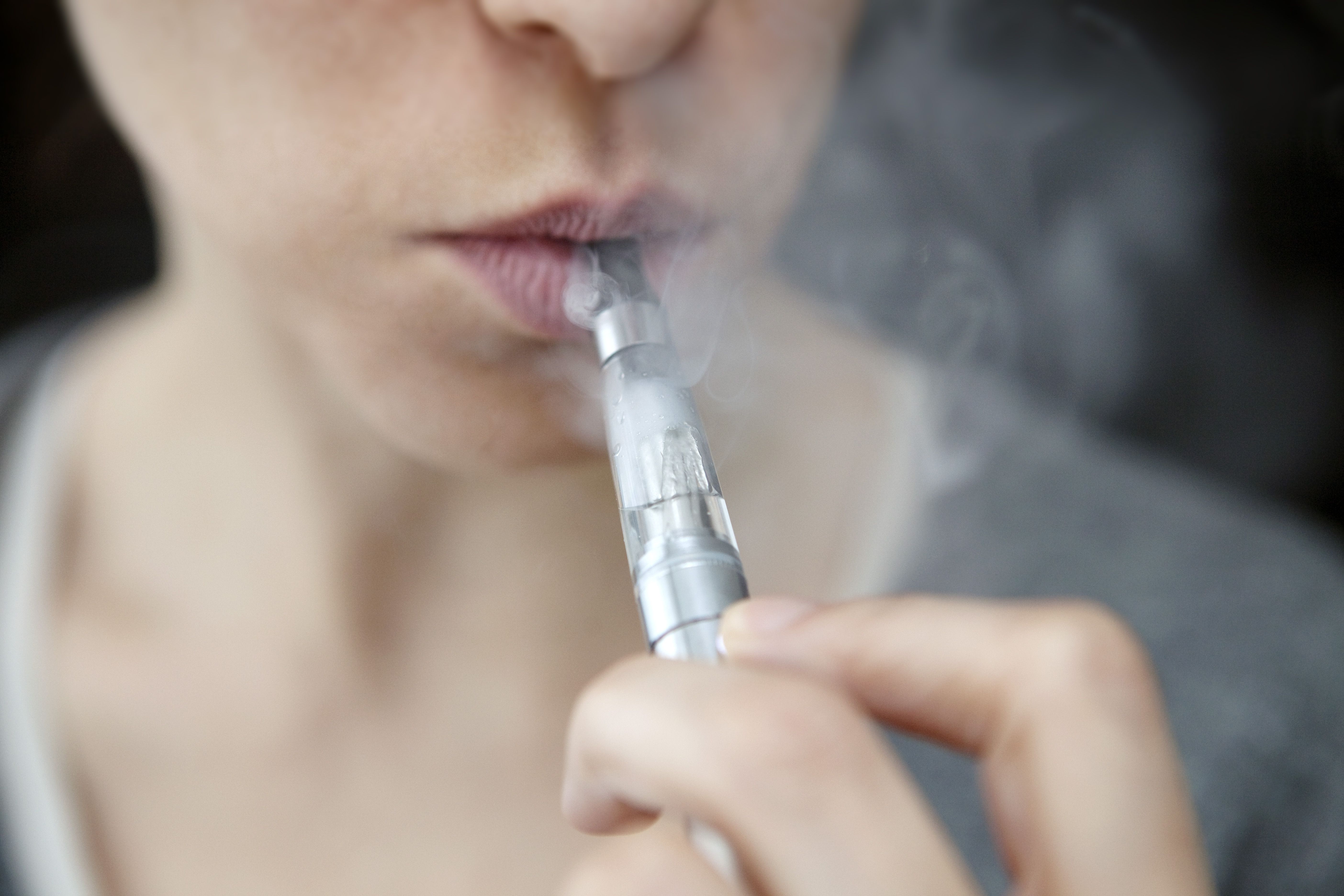In 2019, witnessing someone smoke a legit cigarette—something you hardly see anymore—feels like a blast from the past. But look around next time you’re at a bar, in a park, or even on the sidewalk, and you might spot people discreetly puffing from sleek devices that look like fancy pens or USBs.
10+ chemicals in the aerosol emitted by e-cigarettes are carcinogens and reproductive toxins.*
The usage of these electronic smoking devices—AKA e-cigarettes or vapes—has skyrocketed in the past year or so. Among high school teens, for example, there’s been a 78 percent increase in vape usage between 2017 and 2018, a report by the Food and Drug Administration (FDA) and the Centers for Disease Control and Prevention (CDC) found. And there’s reason to be concerned even if you’re not vaping: Just like cigarettes, e-cigarettes (whether they contain nicotine, marijuana, or something else) emit toxic secondhand aerosol.
This affects more people than you might think. While we don’t have nationwide stats on adults’ exposure to e-cigarette aerosol, we do know that in 2017, more than half of US middle and high school students reported exposure to secondhand smoke or vape. We also know that each year, over half of all Californians are exposed to some form of secondhand smoke, including e-cigarette aerosol, according to researchers.
Why secondhand vape is so dangerous
The dangers of secondhand cigarette smoke—in your home and outdoors—are well-established: It kills over 41,000 non-smoking adults in the U.S. every year, according to a Surgeon General report. And secondhand marijuana smoke contains many of the same cancer-causing substances and toxic chemicals as secondhand tobacco smoke (like ammonia and hydrogen cyanide), according to research published in the journal Chemical Research in Toxicology.
Secondhand aerosol is also dangerous. Not only does it contain ultrafine particles that can increase the risk of cardiovascular disease, but it also contains cancer-causing chemicals. In fact, at least 10 chemicals identified in the aerosol emitted by e-cigarettes are on California’s Proposition 65 list of carcinogens and reproductive toxins, including nicotine, formaldehyde, lead, and toluene (a compound associated with paint thinners).
 BSIPGetty Images
BSIPGetty Images
Further, there might be dangers we’re still not aware of. “When certain chemicals are vaporized, you don’t know what resulting chemicals that might create and how that might affect you,” says Patricia Rich, MD, an Atlanta-based oncologist. For example, heating propylene glycol, a synthetic food additive that serves as the base of many e-cigarette solutions, can actually produce formaldehyde in the aerosol, according to a study published in The New England Journal of Medicine.
Research on the impact of secondhand aerosol inhalation is still in development, and it doesn’t help that there are over 460 brands of e-cigarettes on the market. “Because these are not regulated, we don’t know exactly what chemicals are even in each kind,” says Dr. Rich.
So, how can you protect yourself?
The problem with secondhand vape is that the only way to avoid the health risks is to, well, totally avoid the exposure. “If you can smell it, you’re being exposed,” says Suzaynn Schick, PhD, an environmental scientist at the Center for Tobacco Control Research and Education at the University of California San Francisco. In many cases, the best you can do is remove yourself from the situation. At your home or in your car, set the expectation of a smoke-free environment.
“We need to do the same stuff that we did to limit secondhand smoke from cigarettes.”
That’s only going to get you so far, though. “It’s really about awareness and education,” says Dr. Rich. “There’s this general assumption that this stuff is all safer than cigarettes, and it’s not.” Learn the dangers and know your rights—organizations like the CDC and the American Nonsmokers’ Rights Foundation have fact sheets and toolkits that can help you. “Then, if someone’s vaping around you and says it’s no big deal, you can explain exactly why it is a big deal and why you don’t want to be exposed to it,” says Anamara Ritt-Olson, an assistant professor of Clinical Preventive Medicine at the University of Southern California.
Even more important is getting involved on a grassroots level. “We need to do the same stuff that we did to limit secondhand smoke from cigarettes,” says Ritt-Olson. “A lot of what happened there was due to the power of the people who organized on a community level to change policy.”
Each year, over half of all Californians are exposed to some form of secondhand smoke.**
As of October 1, 2019, 892 municipalities, 21 states, and two territories include e-cigarettes as products that are prohibited from use in 100-percent smoke-free environments. In 1995California was the first state to ban smoking in the workplace, and has been a major player in leading the charge against protecting residents and visitors from harms of secondhand smoke through an array of smoking bans that include everything from e-cigarettes and cigarettes to marijuana and hookah.
If you’re unhappy with secondhand vaping at local restaurants, parks, or other public places, speak up. Ask places you frequent to make their facilities smoke-free, and if you’re somewhere that’s supposed to be a no smoking zone but patrons aren’t following suit, tell someone in a position of authority. And if you’re exposed to secondhand vape because someone you love smokes or vapes, talk to them about quitting. (Get the conversation stated with these tips from NoButts.org.)
It took decades for people to fully understand the dangers of secondhand cigarette smoke; hopefully, it won’t take as long to realize just how dangerous all types of secondhand smoke can be.
To learn more about the dangers of secondhand smoke out SecondhandDangers.org and TobaccoFreeCA.com.
* Source: https://oehha.ca.gov/proposition-65/law/proposition-65-law-and-regulations
**Source: https://www.cdph.ca.gov/Programs/CCDPHP/DCDIC/CTCB/CDPH%20Document%20Library/ResearchandEvaluation/FactsandFigures/CATobaccoFactsandFigures2019.pdf
Source: Read Full Article
